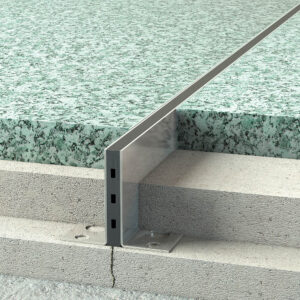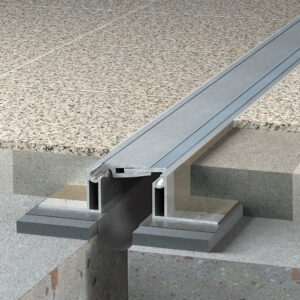Recommendations
CONCOURSES
Expansion Joints
The design plan should accommodate extending expansion joints in the main concourses of airports into shops where required. All expansion and control joints in airports must be robust and able to withstand high point loads as well as punishing levels of pedestrian traffic. High point loads often arise from the use of ‘cherry-pickers’ within airports to clean glass and facades. To accommodate ‘cherry pickers’ and ‘scissor lifts’ it is recommended that E11 loading capacity be considered as the minimum acceptable; E11 equates to a cherry picker of 36kN (3.6 tonnes) fully laden weight.
Control joints
Control joints in internal floors in airports should be laid to form bays to accommodate local moisture movement, such as the drying shrinkage of substrates. They are also used to compensate for small deflections arising from thermal expansion and contraction.
Typically, internal control joints are formed in maximum 6 metre x 6 metre bays in finishes laid on both ground-supported and suspended slabs. With suspended slabs control joints should also be laid directly over beams and at the mid-point of spans where anticipated creep deflection exceeds 20mm.
In high traffic environments such as airports it is strongly recommended that control joints with metal side plates are installed in floors. The reason is that these metal plates help protect and support the finishes from the worst rigours of impact and abrasion which can often result in cracking and spalling of the edges of paving.
LINK BRIDGES
Expansion joints
Link bridges connect entry and exit to and from planes and connect to the main concourse. They should be regarded as separate structures requiring expansion joints at this interface. As separate structures they will generally exhibit movement characteristics (horizontal, vertical and shear) that differ from that of the main terminal building. These movement characteristics must be factored into the selection of the appropriate type of expansion joint to use in these locations.
EXTERNAL FRONT OF HOUSE
Expansion Joints
Expansion joints arise both in the external concourse and between airport terminal buildings and elevated roadways. Often such roadways are sub-divided by expansion joints and joints are also found between elevated roadways and link-bridges to multi-storey car parks at airports.
In these areas the load capacity of selected expansion joint systems is often a major consideration.
The provisions of Eurocode EN-1991-1-1 ‘Actions on structures – General actions, densities, self-weight and imposed loads for buildings’ should be referenced when specifying expansion joints for airport front of house areas. With respect to current Eurocodes it is suggested that loading from Type F (30kN/3.0 tonne passenger cars) and Type G (160kN/16 tonne passenger buses) is specified.
Regarding areas experiencing loading from delivery trucks and fire tenders the provisions of Eurocode EN 1991-2 ‘Traffic loads on bridges’ should be considered and a loading capacity as described in Load Model 2 of this Eurocode may be appropriate.
Control Joints
Control joints in external airport decks and floors should be laid to form 3 metre x 3 metre bays to accommodate local moisture movement and to compensate for the significant deflections arising from thermal expansion and contraction. Control joints in high traffic environments should have metal side plates to support the vulnerable edges of finishes.
EXTERNAL BACK OF HOUSE
Expansion Joints
External back of house areas including baggage handling areas may share the same movement characteristics as the main concourse but may exhibit differing loading requirements. It is therefore important to separately assess the types and gross loads of vehicles using these areas as part of the detailed specification process.




